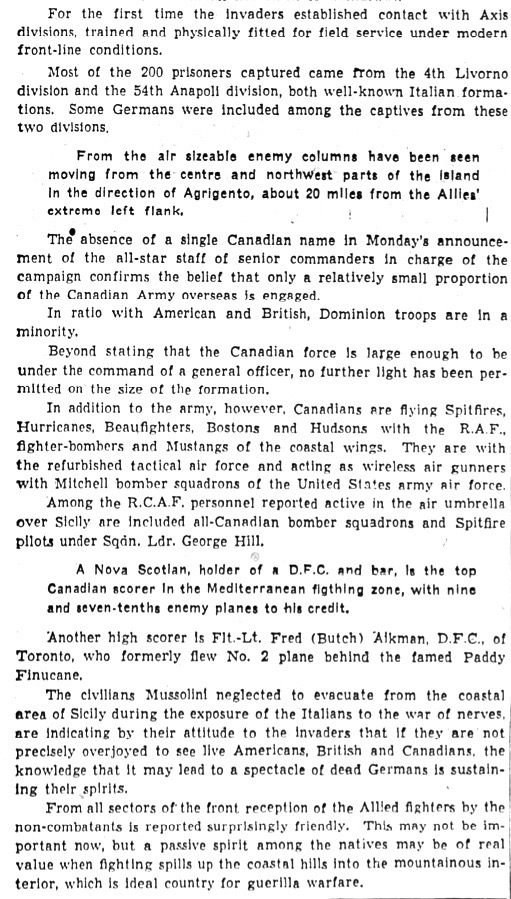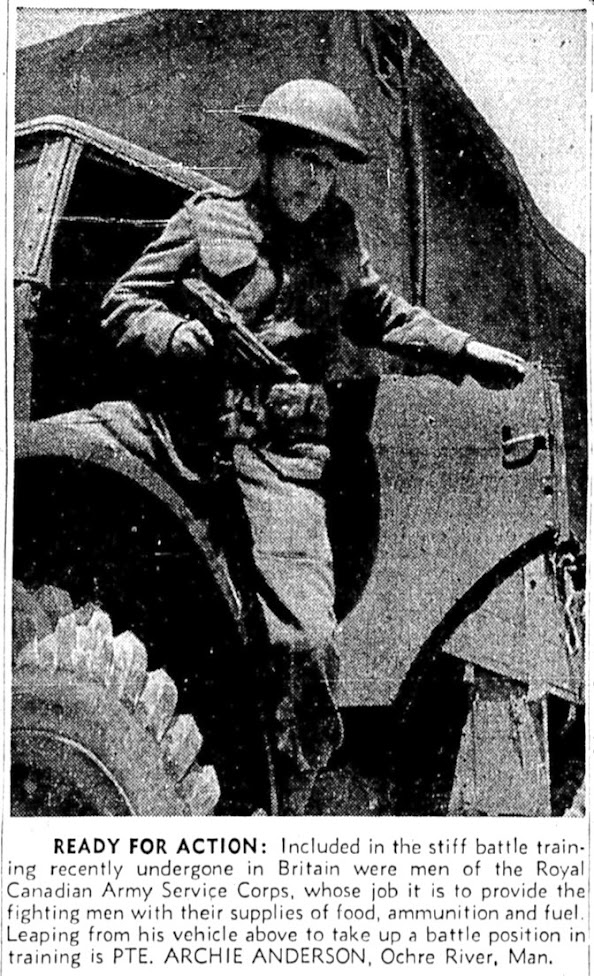July 13 1943, Ross Munro Takes the Cake!
Photo Credit - Library and Archives, Ottawa Canada
Introduction:
This is one instance when a photograph is worth 1,000 words and more. I found it recently posted on a website linked to Facebook called "Canadians in the Italian Campaign in World War II," and as I reflected on the caption I wondered if Ross Munro - in the passenger seat - was able to post a story to a Canadian newspaper on the date mentioned, i.e., July 13 1943.
Thanks to online digitized newspapers (e.g., link to
The Winnipeg Tribune) and reels and more reels of microfiche (e.g.,
The Montreal Star at the University of Western Ontario), I have readily available options to help me answer my own question. Due to COVID-19 I chose the online
Tribune.
The answer is "yes" and more. Munro posted on July 13 and so did other Canadian writers. And I was able to find a paragraph that allowed me to imagine that Canadians in Combined Ops were active as well on that day, transporting men and the materials of war to the shores of Sicily - as Allied troops advanced and cried out for ammunition, more petrol for jeeps, ration tins and much, much more.
Below, readers will find news items from the pen of Canadian writers and photographs that provide a look at action (and folks who are trying to catch a few winks) related to the articles.
Please visit The Winnipeg Tribune by using the link provided above for more information about he various theatres of war, in July and beyond. Happy Hunting, I say.
Before we get to a lengthy article by Ross Munro, I offer a front page piece by another productive Canadian from The Winnipeg Tribune:
Editor's Note: Mr. Allen mentions in the second paragraph from the top that "Syracuse, Avola and Pachino - were taken with Canadians either on the scene actually at the time of surrender, or in the immediate vicinity." And he is correct in more ways than he was aware at the time of writing.
He likely became aware that when Syracuse, Avola and Pachino were taken by Allied Army forces, there were some Canadian troops in the area. But what he likely did not know was that there were other Canadians "on the scene... or in the immediate vicinity" - but they were not connected to the army.
Several hundred members of the Royal Canadian Navy Volunteer Reserve (RCNVR) and Combined Operations had landed British troops (part of Gen. B. Montgomery's Eighth Army) in the 80th and 81st Canadian Flotillas of Landing Craft north of Pachino, between Avola and Syracuse. In Navy memoirs, beaches near Avola (and Noto, farther south) are mentioned more than once.
Leading Seaman Doug Harrison (RCNVR, Comb. Ops, 80th Flotilla) writes:
In late spring of 1943 about two hundred officers and ratings of Combined Ops (CO) left Britain from various ports to man LCMs in the invasion of Sicily on July 10th. Some of these men suffered terribly from dysentery while camped in the desert waiting for slower ships to arrive with their boats and many were still in a weakened condition when they hit the beaches south of Syracuse near a town named Avola and in the Pachino-Marzamemi Beaches further south. These Canadian sailors, with no change of clothing, subsisted on what they could scrounge for themselves for over a month at Sicily.
Some slept on the beaches and on landing craft and one group found safety from bombs in an abandoned limestone cave near the beach. Very damp and lizardly, it was a welcome haven at night.
"Dad, Well Done", page 75.
Doug's commanding officer, Lt. Jake Koyl of Saskatoon, mentions in memoirs that the Canadians landed U.K. troops south of Syracuse at JIG, HOW and GEORGE Beaches. The map below reveals how close the beaches are to Avola, i.e., about 1 mile.:
Photo Credit - Royal Naval Beach Commandos 1942-45
Correspondent Allen was very likely unaware that Canadian sailors were in the vicinity and living in caves near the Avola beaches. During the war, many were the times when the right hand did not know what the left hand was doing. (FYI - Another Navy memoir recounts a sailor's day-long trip into Avola to see what he could see. He likely did not see writer Ralph Allen).
Allan continues:
If the above troops did not make it to Sicily, perhaps they were involved two months later in the invasion of Italy. And while the S.S.R.'s trained atop Universal carriers, the First Canadian Division is drawing closer to Sicily and landing beaches around the corner from Pachino.
Ross Munro offers the following eye-witness account, published in the July 13 issue of The Winnipeg Tribune (but delayed from July 9, 1943):
Readers: Please manoeuvre your way to the top of the right-hand column
above, before continuing with the single column below : )
Though Mr. Munro was not the only Canadian war correspondent in Sicily, he was first off the boat on many occasions, and some related details about his significant stories is mentioned in the July 13 1943 Tribune while he is getting his photo taken in a crowded jeep!
The following article concerns another Canadian war correspondent, Louis V. Hunter... and his wife:
The photo above appeared on the Tribune's front page and I include it here because it is slightly related to the short piece below that is part of a lengthy article that started on the front page as well, on July 13 1943. Below we catch a glimpse of how large the support team had to be in order to feed, fuel and arm the landed Allied armies already moving northwards upon the island of Sicily.
Troop ships and cargo ships off-loaded men and the material of war into assault landing crafts (ALCs or LCAs) and landing craft mechanised (LCMs) which landed and deposited loads continuously for several weeks. Landing crafts and ships filled with tanks and lorries and jeeps and cannons and more men also kept the beaches very busy.
There were no small roles and Pte. Archie Anderson deserves mention for keeping the supply chain moving - soldiers can live without ration tins for a few days but don't slow down the jerry cans of fuel or crates of ammo or there'd be hell to pay. And don't slow down the landing crafts because large ships can't offload when there are no ports available, which was often the case.
Note the last sentence!
Canadian war correspondents catch my eye more frequently now than in the past because they often played for the home team and mentioned Canadian units. And on very rare occasions they mentioned the men (e.g., Canadians in Combined Ops aboard landing crafts, and Archie Anderson, etc.) who helped keep the transportation of men and material of war on schedule.
More to follow from The Winnipeg Tribune concerning Canadian war correspondents. I even think a few Canadians in Combined Operations get mentioned by name!
Unattributed Photos GH

















No comments:
Post a Comment